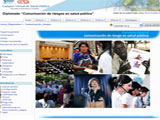
Washington, September 14, 2011.
Seventeen students from 11 countries in the Americas were the first graduates to receive a virtual certificate in “Risk Communication for Public Health,” administered by the Universidad del Norte (Colombia) and the Pan American Health Organization (PAHO/WHO). The seven-month virtual training course, consisting of six different modules, was offered via the Virtual Campus of Public Health (VCPH), PAHO’s regional electronic platform that serves as a tool for technical cooperation with countries of the Americas. As a result of this training, countries will be better able to comply with the International Health Regulations’ mandate to strengthen national capacities to respond to epidemics and/or public health emergencies that pose a danger to national and/or international populations.
 “Today, you have a duty to share what you have learned with others,” said PAHO’s course coordinator, Bryna Brennan, in addressing students during the virtual graduation. “It has been a great opportunity to learn from you, from your views and from the wealth of your experiences. All of your contributions, from the community and institutional perspectives, have been useful and will help to improve health conditions for the populations in your countries.”
“Today, you have a duty to share what you have learned with others,” said PAHO’s course coordinator, Bryna Brennan, in addressing students during the virtual graduation. “It has been a great opportunity to learn from you, from your views and from the wealth of your experiences. All of your contributions, from the community and institutional perspectives, have been useful and will help to improve health conditions for the populations in your countries.”
Certificate recipients will be able to design and implement risk communication strategies for public health and manage coordinated communication efforts in emergencies and crisis situations. Participants included Jorge Segovia and Carolina Casullo (Argentina), Gianna Fuentealba (Chile); Xinia Maria Fernandez (Costa Rica), Gabriel Montalvo and Rodolfo Reyes (Cuba), Marcial Bonilla (Ecuador), Lucero Rodriguez and Ljubica Latinovic (Mexico), Aida Soto Mercedes (Nicaragua), Patricia Lima Pereira (Paraguay); Edwin Napanga, Juan Carlos Arrasco and John Castro Varilla (Peru), Maria Serrana Rubini (Uruguay); and Glenda Rincón and Edison Armando Vivas (Venezuela).
“The big challenge for PAHO/WHO and for all of us is to know how to share the richness of this process, to disseminate information to each of our countries and respective ministries so that they will understand the value and benefits of communications, in general, and risk communication in particular . . . this program has given us new strengths and now we have new tools, both personal and collective. Now we have a network that stretches from Central America to the South and surrounds us all,” said Maria Serrana Rubini, one of the course participants.
The “Risk Communication for Public Health” virtual certificate is aimed at journalists and health professionals from the Ministries of Health and from other public sector institutions involved in health and disasters at the local, national and international level, including the United Nations system; and non-profit organizations. Teachers and University professors of communications and non-profit leaders in the Americas are also invited to participate.
“We thank the tutors, the technical advisors and managers—the team who has worked with us during these months of preparation and implementation of this educational experience. This course has trained an elite group of professionals who now have the ability to develop risk communication strategies to effectively respond to any public health emergency that arises in the region. The challenge will be to measure the impact that this experience will have on their institutions and countries,” said Jesus Arroyave, the certificate academic coordinator.
This training initiative, developed as a virtual tutorial model, began in February 2011, thanks to an agreement signed between PAHO / WHO and the Universidad del Norte, with funding from the Canadian International Development Agency (CIDA), the Canadian Government, and the Centers for Disease Control and Prevention (CDC). PAHO will soon announce a call for applications for the 2012 “Risk Communication for Public Health,” virtual certificate, accepting up to 60 participants for the second cohort.
